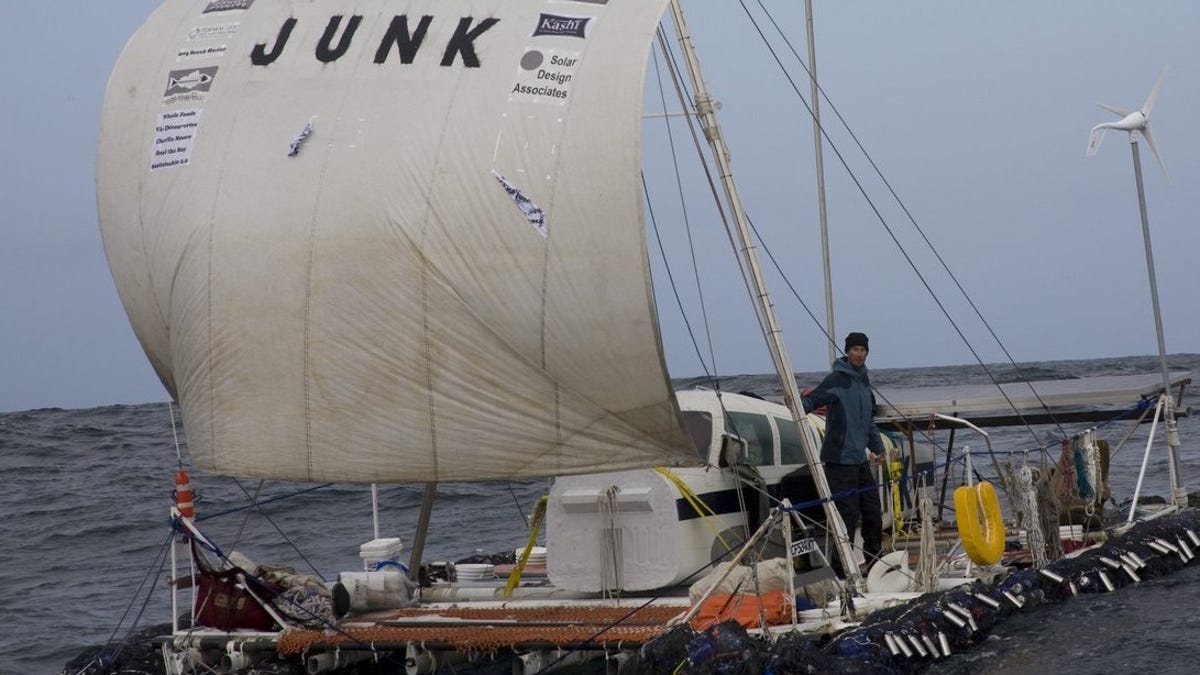 Why You Can Trust CNET
Why You Can Trust CNET Junk journey highlights 'plastic soup' of Pacific Ocean
To draw attention to plastic pollution in the Pacific, two sailors are crossing 2,100 miles on a craft built from 15,000 recycled bottles and a Cessna cockpit.

Sailing 4,000 miles on the Pacific Ocean made Marcus Eriksen and Joel Paschal sick. It wasn't waves that turned their stomachs, but the amount of plastic garbage they encountered on a voyage with the Algalita Marine Research Foundation earlier this year.
The activists wanted more people to share their disgust about plastic litter that swirls, relatively unexplored, in continent-size patches of ocean.
To that end, they have built a motor-less craft from 15,000 recycled beverage bottles, fishing nets, and the cockpit of a Cessna, and are sailing it more than 2,000 miles from southern California to Hawaii. They left Long Beach, Calif., on Sunday.
The 1.5-ton junk features a solar panel and wind turbine to power GPS and other devices. It's made of six pontoons each 30 feet long, filled with 2,000 soda and sports drink bottles, and triple-wrapped in used fishing nets. Twenty sailboat masts provide a frame, secured to a cabin cut from a Cessna 310 fuselage.
On the last Pacific voyage that ended in February, Eriksen and Paschal helped marine researcher Charles Moore assess the extent of pollution in the waters leading up to the Great Pacific Garbage Patch, a swirling mass of plastic debris some estimate to be as large as the United States.
In early tests, a sample showed 48 parts of plastic to each part of plankton.
"They haven't finished processing the samples, but there was an exponential increase in the plastic," said Anna Cummins, who was also aboard and serves as Algalita's education adviser. "What looked on the surface like clean water, when you pulled it up, it looked like plastic soup. It was disgusting."
Algalita researchers said the floating, soupy landfill isn't well understood because satellites can't spot the translucent particles. And although efforts by scientists to explore plastic in five gyres around the world have been lacking, interest is expanding as the public learns more.
"No one really knows what's out in the other gyres," Cummins said. "In the north Pacific alone there's Capt. Moore with his research boat. We are a small organization with five or six paid staff members."
Eighty percent of the plastic comes not from ships but from land, where tossed consumer goods eventually travel from beaches and rivers into the ocean, according to Algalita.
Plastic concentrates poisons such as PCBs at levels a million times higher than found in the water, according to Japanese researchers.
The amount of plastic produced in the United States has nearly doubled in the past two decades, according to the American Chemistry Council.
"Recycling isn't the solution," Cummins said. "We think there absolutely needs to be a reduction in the overall use and consumption of plastic."
Cummins said she backs the attention-getting adventure but feels nervous about the safety of Paschal and Eriksen, her fiance.
"Yes, we are risking our lives, but the issue of petroleum-based plastic and our national dependence on petroleum, warrant urgent action," noted Eriksen on a blog that will chronicle the journey.
However, he added, the sailboat masts and aluminum airplane fuselage are easy for radar to detect. "We have a better chance of being seen by big ships than typical fiberglass sailboats do."
Two satellite telephones keep the sailors in touch with the rest of the world. They also have several GPS units, VHF radios, and a Coast Guard beacon. Three months' worth of food includes a bucket of Hershey's Kisses.
It's not the first junk journey for Eriksen, who holds a doctorate in science education. After serving as a Marine in the Gulf War, he traveled the Mississippi River in a handmade raft of plastic bottles, then wrote a book about the trip.
The current odyssey is costing between $40,000 to $50,000, with big support from donations, Cummins said. Most of the bottles were given by a Burbank, Calif., recycling center. Patagonia gave the crew 500 Nalgene bottles being phased out due to concerns about bisphenol-A leaching from them.
The crew, towed first to San Nicolas Island before setting sail, encountered gale force winds Tuesday night. They plan to arrive in Hawaii in about six weeks.